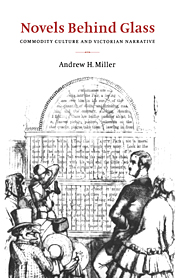Book contents
- Frontmatter
- Contents
- List of illustrations
- Acknowledgements
- Introduction
- 1 Longing for sleeve buttons
- 2 Spaces of exchange: interpreting the Great Exhibition of 1851
- 3 The fragments and small opportunities of Cranford
- 4 Rearranging the furniture of Our Mutual Friend
- 5 Owning up: possessive individualism in Trollope's Autobiography and The Eustace Diamonds
- 6 Middlemarch and the solicitudes of material culture
- Afterword
- Works cited
- Index
2 - Spaces of exchange: interpreting the Great Exhibition of 1851
Published online by Cambridge University Press: 17 August 2009
- Frontmatter
- Contents
- List of illustrations
- Acknowledgements
- Introduction
- 1 Longing for sleeve buttons
- 2 Spaces of exchange: interpreting the Great Exhibition of 1851
- 3 The fragments and small opportunities of Cranford
- 4 Rearranging the furniture of Our Mutual Friend
- 5 Owning up: possessive individualism in Trollope's Autobiography and The Eustace Diamonds
- 6 Middlemarch and the solicitudes of material culture
- Afterword
- Works cited
- Index
Summary
A man with a reflective turn of mind, walking through an exhibition of this sort will not be oppressed, I take it, by his own or other people's hilarity.
William ThackerayThe world exhibitions glorify the exchange value of commodities.
Walter BenjaminThackeray exhibits the constantly circulating, incessantly dispiriting objects I considered in the last chapter in a curiously planar space; compared, for instance, to the involuted nooks and crannies, insides and outsides, of Dickens' novels, the space of Thackeray's failed allegories is remarkably depthless and two-dimensional. The contiguity of objects within the space of perspectival realism is rendered insignificant by the insistence with which those objects refer to an abstract level of meaning, represented most fully, as I argued, by death:
As you ascend the staircase of your house from the drawing- towards the bed-room floors, you may have remarked a little arch in the wall right before you, which at once gives light to the stair which leads from the second story to the third (where the nursery and servants' chambers commonly are), and serves for another purpose of utility, of which the undertaker's men can give you a notion. They rest the coffins upon that arch, or pass them through it so as not to disturb in any unseemly manner the cold tenant slumbering within the black ark.
(Vanity Fair, p. 768)The movement we saw Thackeray make in the last chapter, up from the gazing footmen to the “fine folks” in the drawing-room, is here negated by a contrary movement, made down the steps by the undertaker's men.
- Type
- Chapter
- Information
- Novels behind GlassCommodity Culture and Victorian Narrative, pp. 50 - 90Publisher: Cambridge University PressPrint publication year: 1995



